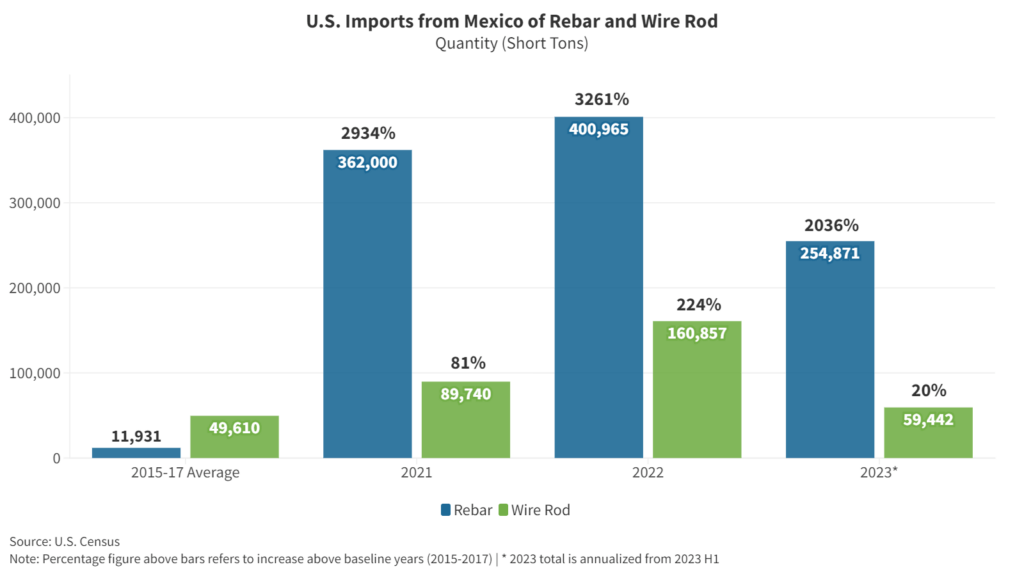Key Points
- Steel imports from Mexico have surged in recent years. Some steel products, such as rebar have increased by several thousand percent over previous import levels.
- Mexico has violated the 2019 U.S.-Mexico agreement to maintain steel imports at past levels. The agreement was made when Mexico was exempted from the 25% steel tariffs under Section 232.
- Mexico has also failed to report the source of the raw steel it imports for use in production of finished steel products. Nearly all imports of steel into Mexico in 2022 were from undetermined sources.
- Excessive steel imports from Mexico harms U.S. steel manufacturers and costs U.S. jobs. Action is needed by the Biden administration to enforce the 2019 agreement with the Mexican government, and if necessary, re-impose the Section 232 tariff of 25% on all Mexican steel imports.
Steel Imports from Mexico Continue to Surge
The U.S. reached an agreement with Mexico in May 2019 that allowed steel imports from Mexico to enter the U.S. duty free and avoid the 25% tariffs on steel under the Section 232 tariffs imposed on global steel imports provided Mexico held steel imports to the historical baseline levels of 2015-2017. Yet, despite the agreement, imports of several key steel products have surged far beyond this baseline over the past two years.
Mexico has continued to exceed agreed upon levels. Its firms are selling steel into the U.S. at as much as 25% below the domestic market price, which harms U.S. steel producers’ ability to produce at a fair price. Two such long steel goods are wire rod and rebar. Rebar is used to reinforce concrete in construction. Wire rod is smaller in diameter and used in a variety of products such as wire mesh or chain link fencing.
Figure 1 shows the import of rebar and wire rod from Mexico over the past two years compared to a historical average from 2015-2017. Both wire rod and rebar are far above import levels seen in the years 2015-2017, considered the historical baseline in the 2019 agreement. The baseline period shows a very small amount of rebar imported from Mexico of only about 11,931 short tons per year. Over the past two years and an annualized 2023 figure, rebar imports from Mexico are up over two thousand percent to hundreds of thousands of tons of rebar imported annually. Wire rod also saw an increase by as much as 224% over the baseline.
Figure 1: U.S. Imports of Rebar and Wire Rod from Mexico (2015-17 Compared to Recent Years)

Table 1 shows that steel imports from Mexico have been elevate at the chapter level as well over the past two years. In the Harmonized Tariff Schedule (HTS) data, iron and steel products are grouped into two chapters. Chapter 72 includes iron and steel products. Chapter 73 includes articles derived from iron and steel. This table compares recent U.S. steel imports from Mexico by chapter to the benchmarked period from 2015 to 2017.
Table 1: U.S. Imports of Iron & Steel from Mexico by Quantity (Short Tons)
| Benchmark Period (2015-2017) | 2021 Imports | 2022 Imports | 2022 Compared to Baseline | |
| Iron & Steel (Chapter 72) |
2.430 M | 4.297 M | 4.670 M | 92% |
| Articles Made of Iron & Steel (Chapter 73) |
2.418 M | 2.748 M | 3.061 M | 26% |
Source: U.S. Census Bureau
Unverified Sources of Mexican Steel Violate Agreement
In addition to maintaining levels near the historical baseline, part of Mexico’s obligations under the agreement was to provide greater transparency into the origin of the raw steel sourced from third-party countries.
In 2019 through November 2021, Mexico’s import data was provided from the Ministry of the Economy and identified the third-party countries from which imports of raw or semifinished steel were sourced. In 2022, Mexico’s National Institute of Statistics began reporting import data and no longer included the third-party country source for most steel imports.
For example, in 2021 only about 10% of semifinished products of iron or nonalloy steel (HTS 7207.20) has an unidentified source, with the U.S. accounting for about 40% of the imports but also specific shares from Brazil, Cuba, Venezuela, Argentina, and the Netherlands. In 2022, the new reporting agency listed only the U.S. as an import source of semifinished product.
Not only has Mexico not held to their end of the agreement to limit steel imports to historical levels, but it has also failed to document the source of raw steel used for finishing in Mexico. Duty-free access from Mexico to the U.S. makes it an attractive potential transshipment point for other countries, especially Chinese steel with its large global overcapacity. The U.S. has no visibility to the origin of the raw steel.
Urgent Action Needed to Counter the Mexican Steel Surge
Mexico has not held to their end of the agreement to limit steel imports to the U.S. at historical levels. Instead, steel imports from Mexico to the U.S. have surged over that time period both in terms of value and quantity. Mexico’s surge of steel imports is not limited to wire rod and rebar, but other products such as pipe and tube as our previous analysis showed.
The re-imposition of the Section 232 tariffs of 25% on Mexican steel imports – or an import quota system guaranteeing compliance – should be considered as the Mexican government has not met their side of the agreement. Urgent action is needed by the Biden administration to take a firmer stance toward steel imports from Mexico to ensure fairness for U.S. steel manufacturers and workers.













